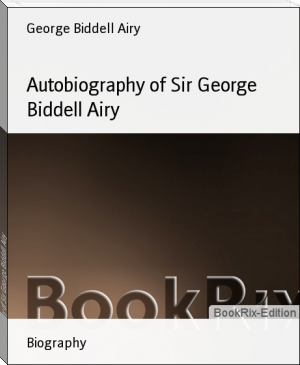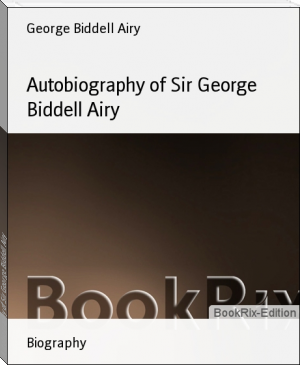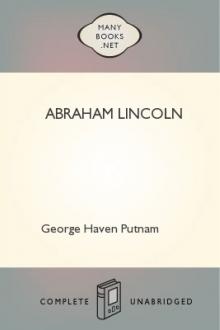Autobiography of Sir George Biddell Airy by George Biddell Airy (e reader for manga .TXT) 📕

- Author: George Biddell Airy
Book online «Autobiography of Sir George Biddell Airy by George Biddell Airy (e reader for manga .TXT) 📕». Author George Biddell Airy
case. The difference of flexures of the two ends has been altered more than a second of arc.--Referring to a new Portable Altazimuth which had lately been tested, the Report states as follows: 'I may mention that a study of defects in the vertical circle of a small Altazimuth formerly used by me, and an inspection of the operations in the instrument-maker's work-shop, have convinced me that the principal error to be feared in instruments of this class is ovality of the graduated limb; this cannot be eliminated by two microscopes, and such an instrument should never be fitted with two only. Our instrument has four.'--'In Osler's Anemometer, a surface of 2 square feet is now exposed to the wind instead of one foot as formerly; and the plate is supported by weak vertical springs instead of rods running on rollers. Its indications are much more delicate than formerly.'--'The Meteors on Nov. 14th were well observed. Eight thousand and three hundred were registered. The variations of frequency at different times were very well noted. The points of divergence were carefully determined.'--Referring to the gradual improvement in the steadiness of chronometers from 1851 to 1866, it appears that from 1851 to 1854 the 'trial number' (which is a combination of changes of weekly rate representing the fault of the chronometer) varied from 34.8s to 52.5s, while from 1862 to 1866 it varied from 21.2s to 25.8s.--The following statement will shew the usual steadiness of the Great Clock on the Westminster Palace: On 38 per cent. of days of observation, the clock's error was below 1s. On 38 per cent, the error was between 1s and 2s. On 21 per cent. it was between 2s and 3s. On 2 per cent. between 3s and 4s. On 1 per cent. between 4s and 5s.--The Report contains an account of the determination of the longitude of Cambridge U.S. by Dr B. A. Gould, by means of galvanic currents through the Atlantic Cable, in the spring of 1867: and advantage was taken of this opportunity for re-determining the longitude of Feagh Main near Valencia in Ireland. The longitude of Feagh Main, found by different methods is as follows: By chronometers in 1844, 41m 23.23s; by galvanic communication with Knight's Town in 1862, 41m 23.37s; by galvanic communication with Foilhommerum in 1866, 41m 23.19s. The collected results for longitude of Cambridge U.S. from different sources are: By moon-culminators (Walker in 1851, and Newcomb in 1862-3), 4h 44m 28.42s and 4h 44m 29.56s respectively; by Eclipses (Walker in 1851), 4h 44m 29.64s; by occultations of Pleiades (Peirce 1838-1842, and 1856-1861), 4h 44m 29.91s and 4h 44m 30.90s respectively; by chronometers (W. C. Bond in 1851, and G. P. Bond in 1855), 4h 44m 30.66s and 4h 44m 31.89s respectively; by Atlantic Cable 1866, 4h 44m 30.99s.--After noticing that many meteorological observatories had suddenly sprung up and had commenced printing their observations in detail, the Report continues thus: 'Whether the effect of this movement will be that millions of useless observations will be added to the millions that already exist, or whether something may be expected to result which will lead to a meteorological theory, I cannot hazard a conjecture. This only I believe, that it will be useless, at present, to attempt a process of mechanical theory; and that all that can be done must be, to connect phenomena by laws of induction. But the induction must be carried out by numerous and troublesome trials in different directions, the greater part of which would probably be failures.'--There was this year an annular eclipse; I made large preparations at the limits of the annularity; failed entirely from very bad weather."--In this year Airy contributed a Paper to the Institution of Civil Engineers 'On the use of the Suspension Bridge with stiffened roadway for Railway and other Bridges of Great Span,' for which a Telford Medal was awarded to him by the Council of the Institution. And he communicated several Papers to the Royal Society and the Royal Astronomical Society.
Of private history: There was the usual visit to Playford in January.--In April there was a short run to Alnwick and the neighbourhood, in company with Mr and Mrs Routh.--From June 27th to July 4th he was in Wales with his two eldest sons, visiting Uriconium, &c. on his return.--From August 8th to Sept. 7th he spent a holiday in Scotland and the Lake District of Cumberland with his daughter Christabel, visiting the Langtons at Barrow House, near Keswick, and Isaac Fletcher at Tarn Bank.
In June of this year (1867) Airy was elected an Honorary Fellow of his old College of Trinity in company with Connop Thirlwall, the Bishop of St David's. They were the first Honorary Fellows elected by the College. The announcement was made in a letter from the Master of Trinity (W.H. Thompson), and Airy's reply was as follows:
ROYAL OBSERVATORY, GREENWICH,
LONDON, S.E.
1867, June 12th .
MY DEAR MASTER,
I am very much gratified by your kind note received this morning, conveying to me the notice that the Master and Sixteen Senior Fellows had elected me, under their new powers, as Honorary Fellow of the College.
It has always been my wish to maintain a friendly connection with my College, and I am delighted to receive this response from the College. The peculiar form in which the reference to the Statute enables them to put it renders it doubly pleasing.
As the Statute is new, I should be obliged by a copy of it. And, at any convenient time, I should be glad to know the name of the person with whom I am so honorably associated.
I am, My dear Master,
Very faithfully yours,
G.B. AIRY.
* * * * *
Consequent on Airy's proposals in 1866 for the introduction of new physical subjects into the Senate-House Examination and his desire that the large number of questions set in Pure Mathematics, or as he termed it "Useless Algebra," should be curtailed, there was a smart and interesting correspondence between him and Prof. Cayley, who was the great exponent and advocate of Pure Mathematics at Cambridge. Both of them were men of the highest mathematical powers, but diametrically opposed in their views of the use of Mathematics. Airy regarded mathematics as simply a useful machine for the solution of practical problems and arriving at practical results. He had a great respect for Pure Mathematics and all the processes of algebra, so far as they aided him to solve his problems and to arrive at useful results; but he had a positive aversion to mathematical investigations, however skilful and elaborate, for which no immediate practical value could be claimed. Cayley on the contrary regarded mathematics as a useful exercise for the mind, apart from any immediate practical object, and he considered that the general command of mathematics gained by handling abstruse mathematical investigations (though barren in themselves) would be valuable for whatever purpose mathematics might be required: he also thought it likely that his researches and advances in the field of Pure Mathematics might facilitate the solution of physical problems and tend to the progress of the practical sciences. Their different views on this subject will be seen from the letters that follow:
ROYAL OBSERVATORY, GREENWICH,
LONDON, S.E.
1867, Nov. 8 .
MY DEAR SIR,
I think it best to put in writing the purport of what I have said, or have intended to say, in reference to the Mathematical Studies in the University.
First, I will remark on the study of Partial Differential Equations. I do not know that one branch of Pure Mathematics can be considered higher than another, except in the utility of the power which it gives. Measured thus, the Partial Differential Equations are very useful and therefore stand very high, as far as the Second Order. They apply, to that point, in the most important way, to the great problems of nature concerning time , and infinite division of matter , and space : and are worthy of the most careful study. Beyond that Order they apply to nothing. It was for the purpose of limiting the study to the Second Order, and at the same time working it carefully, philosophically, and practically, up to that point, that I drew up my little work.
On the general question of Mathematical Studies, I will first give my leading ideas on what I may call the moral part. I think that a heavy responsibility rests on the persons who influence most strongly the course of education in the University, to direct that course in the way in which it will be most useful to the students--in the two ways, of disciplining their powers and habits, and of giving them scientific knowledge of the highest and most accurate order (applying to the phenomena of nature) such as will be useful to them through life. I do not think that the mere personal taste of a teacher is sufficient justification for a special course, unless it has been adopted under a consideration of that responsibility. Now I can say for myself that I have, for some years, inspected the examination papers, and have considered the bearing of the course which they imply upon the education of the student, and am firmly convinced that as regards men below the very few first--say below the ten first--there is a prodigious loss of time without any permanent good whatever. For the great majority of men, such subjects as abstract Analytical Geometry perish at once. With men like Adams and Stokes they remain, and are advantageous; but probably there is not a single man (beside them) of their respective years who remembers a bit, or who if he remembers them has the leisure and other opportunities of applying them.
I believe
Of private history: There was the usual visit to Playford in January.--In April there was a short run to Alnwick and the neighbourhood, in company with Mr and Mrs Routh.--From June 27th to July 4th he was in Wales with his two eldest sons, visiting Uriconium, &c. on his return.--From August 8th to Sept. 7th he spent a holiday in Scotland and the Lake District of Cumberland with his daughter Christabel, visiting the Langtons at Barrow House, near Keswick, and Isaac Fletcher at Tarn Bank.
In June of this year (1867) Airy was elected an Honorary Fellow of his old College of Trinity in company with Connop Thirlwall, the Bishop of St David's. They were the first Honorary Fellows elected by the College. The announcement was made in a letter from the Master of Trinity (W.H. Thompson), and Airy's reply was as follows:
ROYAL OBSERVATORY, GREENWICH,
LONDON, S.E.
1867, June 12th .
MY DEAR MASTER,
I am very much gratified by your kind note received this morning, conveying to me the notice that the Master and Sixteen Senior Fellows had elected me, under their new powers, as Honorary Fellow of the College.
It has always been my wish to maintain a friendly connection with my College, and I am delighted to receive this response from the College. The peculiar form in which the reference to the Statute enables them to put it renders it doubly pleasing.
As the Statute is new, I should be obliged by a copy of it. And, at any convenient time, I should be glad to know the name of the person with whom I am so honorably associated.
I am, My dear Master,
Very faithfully yours,
G.B. AIRY.
* * * * *
Consequent on Airy's proposals in 1866 for the introduction of new physical subjects into the Senate-House Examination and his desire that the large number of questions set in Pure Mathematics, or as he termed it "Useless Algebra," should be curtailed, there was a smart and interesting correspondence between him and Prof. Cayley, who was the great exponent and advocate of Pure Mathematics at Cambridge. Both of them were men of the highest mathematical powers, but diametrically opposed in their views of the use of Mathematics. Airy regarded mathematics as simply a useful machine for the solution of practical problems and arriving at practical results. He had a great respect for Pure Mathematics and all the processes of algebra, so far as they aided him to solve his problems and to arrive at useful results; but he had a positive aversion to mathematical investigations, however skilful and elaborate, for which no immediate practical value could be claimed. Cayley on the contrary regarded mathematics as a useful exercise for the mind, apart from any immediate practical object, and he considered that the general command of mathematics gained by handling abstruse mathematical investigations (though barren in themselves) would be valuable for whatever purpose mathematics might be required: he also thought it likely that his researches and advances in the field of Pure Mathematics might facilitate the solution of physical problems and tend to the progress of the practical sciences. Their different views on this subject will be seen from the letters that follow:
ROYAL OBSERVATORY, GREENWICH,
LONDON, S.E.
1867, Nov. 8 .
MY DEAR SIR,
I think it best to put in writing the purport of what I have said, or have intended to say, in reference to the Mathematical Studies in the University.
First, I will remark on the study of Partial Differential Equations. I do not know that one branch of Pure Mathematics can be considered higher than another, except in the utility of the power which it gives. Measured thus, the Partial Differential Equations are very useful and therefore stand very high, as far as the Second Order. They apply, to that point, in the most important way, to the great problems of nature concerning time , and infinite division of matter , and space : and are worthy of the most careful study. Beyond that Order they apply to nothing. It was for the purpose of limiting the study to the Second Order, and at the same time working it carefully, philosophically, and practically, up to that point, that I drew up my little work.
On the general question of Mathematical Studies, I will first give my leading ideas on what I may call the moral part. I think that a heavy responsibility rests on the persons who influence most strongly the course of education in the University, to direct that course in the way in which it will be most useful to the students--in the two ways, of disciplining their powers and habits, and of giving them scientific knowledge of the highest and most accurate order (applying to the phenomena of nature) such as will be useful to them through life. I do not think that the mere personal taste of a teacher is sufficient justification for a special course, unless it has been adopted under a consideration of that responsibility. Now I can say for myself that I have, for some years, inspected the examination papers, and have considered the bearing of the course which they imply upon the education of the student, and am firmly convinced that as regards men below the very few first--say below the ten first--there is a prodigious loss of time without any permanent good whatever. For the great majority of men, such subjects as abstract Analytical Geometry perish at once. With men like Adams and Stokes they remain, and are advantageous; but probably there is not a single man (beside them) of their respective years who remembers a bit, or who if he remembers them has the leisure and other opportunities of applying them.
I believe
Free e-book «Autobiography of Sir George Biddell Airy by George Biddell Airy (e reader for manga .TXT) 📕» - read online now
Similar e-books:





Comments (0)